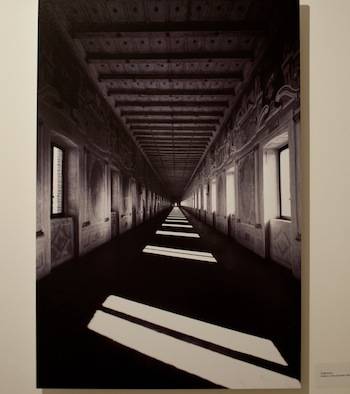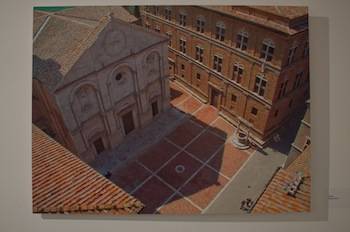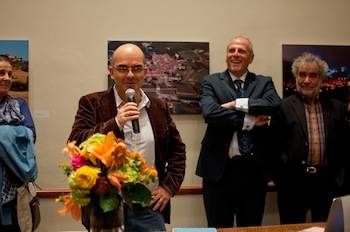Italian Ideal Cities in New York
Humanism, stands for devotion to the literature of ancient Greece and Rome. Intellectual Greek and Roman teachings undertaken by scholars, writers, and civic leaders, today known as Renaissance humanists, began initially in Italy, and then spread across most of Europe.
This month, Casa Italiana Zerilli Marimò brings to their gallery space an exquisite photographic exhibition titled Renaissance Ideal Cities. On view until October 3rd are photographs of two UNESCO World Heritage Centre towns: the Sienese city of Pienza and the Mantuan city of Sabbioneta.
The historic centre of Pienza is a true and a first application of the Renaissance humanist concept of urban design. The town played a pivotal role in the development of the concept of the planned 'ideal city' in subsequent urban development in ltaly as well as beyond its borders.
In 1459, Pope Pius II decided to transform the look of his birthplace. He chose the architect Bernardo Rossellino, whom applying the principles of his mentor, Leon Battista Alberti, first implemented Renaissance town-planning concepts resulting in the ideal square known as Piazza Pio II and the buildings around it: the Piccolomini and the Borgia Palaces.
Similarly, Sabbioneta is the creation of one man, the ruler of the little state Vespasiano Gonzaga Colonna, who studied the writings and theories of ideal city planning and aimed to build an impregnable fortress and a functional capital of the state.
Sabbioneta, created in the second half of the 16th century, can be described as a single-period city and is known for the right angle grid layout. It's defensive walls, grid pattern of streets, role of public spaces and monuments, make Sabbioneta one of the finest examples of ideal cities built in Europe. The ideals of the Renaissance, and the humanism concept are heavily present in the towns’ architecture.
Present (virtually at least) at the opening of the exhibit was Marco Aroldi, the mayor of the city of Sabbioneta who expressed gratitude to the director of Casa Italiana for giving voice to the his city across the ocean.
"It is a great honor for me to represent my city on this occasion of the exhibit arriving in NY," stated Aroldi via a Skype video call. Albertini called the exhibition "virtuous on many levels, as it imports quality products without creating a major expense for the state or public administrations."
The audience also had an opportunity to meet Casa Italiana director's mother, who being a Mantuan herself, was also present at the Teatro all’Antica for the Skype conversation despite the late hour caused by the time difference.
Finally, an enticing presentation was given by Prof. Nicola Gardini of Oxford University (NYU Alumn) who described the two cities as ones that "bracket the Renaissance." "Pienza is the begging of antiquity and rationalism based on ancient values, and Sabbioneta is the swan song of the thought of reproducing antiquity as a form of modernity," eloquently stated Gardini.
"These are twin cities, yet they they mark the beginning and the end of this architectural and moral culture… In Sabbionetta we walk in the dream, contemplating moral perfection. Sabbioneta is still talking a lot… in its paintings, the theater … everything echoes everything, and it is like moving around a beautifully constructed poem, a Ciceronian oration … this is where politics and arts become one," he continued. "We are lucky to have such cities… we are in the Renaissance there…" concluded Prof. Gardini.
Next Monday, October 23rd, at 6PM Casa Italiana twill hold a screening of two films La Strategia del Ragno by Bernardo Bertolucci and Le Piacevoli Notti by Armando Crispino e Luciano Lucignani. Bertolucci's film is entirely shot in Sabbioneta, and the last part of the second film is shot in Pienza. Come and let Casa Italiana transport you to an ideal Renaissance city…. even if only for a short while…
FOR MORE PICTURES VISIT I-ITALY FACEBOOK PAGE - CLICK HERE >>>







































i-Italy
Facebook
Google+
This work may not be reproduced, in whole or in part, without prior written permission.
Questo lavoro non può essere riprodotto, in tutto o in parte, senza permesso scritto.